remove seats Citroen C4 PICASSO 2016 2.G Owner's Manual
[x] Cancel search | Manufacturer: CITROEN, Model Year: 2016, Model line: C4 PICASSO, Model: Citroen C4 PICASSO 2016 2.GPages: 527, PDF Size: 13.72 MB
Page 12 of 527
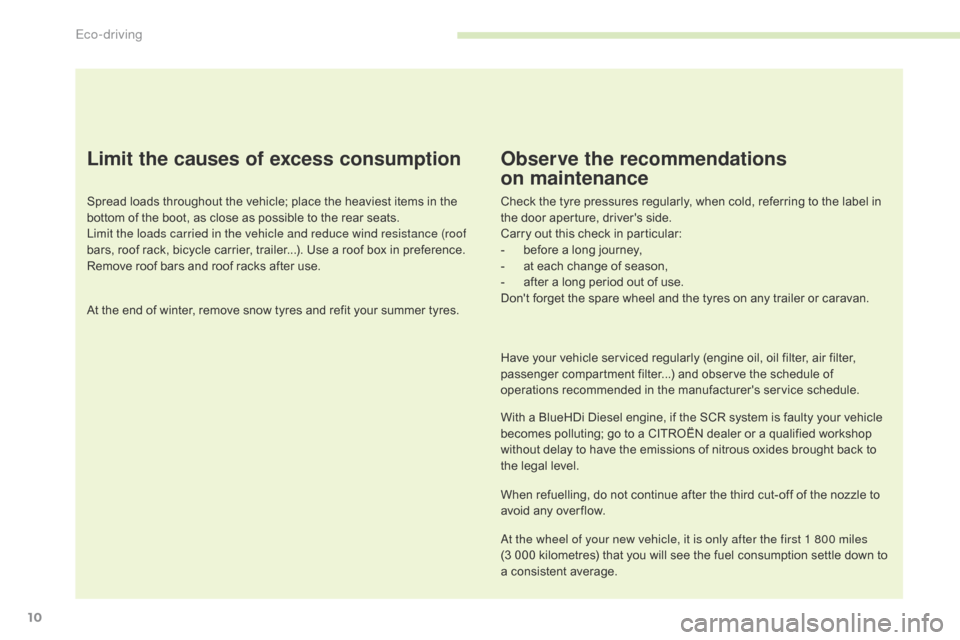
10
C4-Picasso-II_en_Chap00c_eco-conduite_ed01-2016
Limit the causes of excess consumption
Spreadô loadsô throughoutô theô vehicle;ô placeô theô heaviestô itemsô inô theô bottom ô of ô the ô boot, ô as ô close ô as ô possible ô to ô the ô rear ô seats.
Limit the loads carried in the vehicle and reduce wind resistance (roof
bars,
ô roof ô rack, ô bicycle ô carrier, ô trailer...). ô Use ô a ô roof ô box ô in ô preference.
Remove
ô roof ô bars ô and ô roof ô racks ô after ô use.
At
ô the ô end ô of ô winter, ô remove ô snow ô tyres ô and ô refit ô your ô summer ô tyres.
Observe the recommendations
on maintenance
Checkô theô tyreô pressuresô regularly,ô whenô cold,ô referringô toô theô labelô inô the ô door ô aperture, ô driver's ô side.
Carry
ô out ô this ô check ô in ô particular:
-
ô
b
efore ô a ô long ô journey,
-
ô
a
t ô each ô change ô of ô season,
-
ô
a
fter ô a ô long ô period ô out ô of ô use.
Don't
ô forget ô the ô spare ô wheel ô and ô the ô tyres ô on ô any ô trailer ô or ô caravan.
Have
ô your ô vehicle ô serviced ô regularly ô (engine ô oil, ô oil ô filter, ô air ô filter, ô
p
assenger ô compartment ô filter...) ô and ô observe ô the ô schedule ô of ô
o
perations ô recommended ô in ô the ô manufacturer's ô service ô schedule.
With
ô a ô BlueHDi ô Diesel ô engine, ô if ô the ô SCR ô system ô is ô faulty ô your ô vehicle ô
b
ecomes ô polluting; ô go ô to ô a ô CITROûN ô dealer ô or ô a ô qualified ô workshop ô
w
ithout ô delay ô to ô have ô the ô emissions ô of ô nitrous ô oxides ô brought ô back ô to ô
t
he ô legal ô level.
When
ô refuelling, ô do ô not ô continue ô after ô the ô third ô cut-off ô of ô the ô nozzle ô to ô
a
void ô any ô over flow.
At the wheel of your new vehicle, it is only after the first 1 800 miles
(3ô 000
ô kilometres) ô that ô you ô will ô see ô the ô fuel ô consumption ô settle ô down ô to ô
a
ô consistent ô average.
Eco-driving
Page 85 of 527
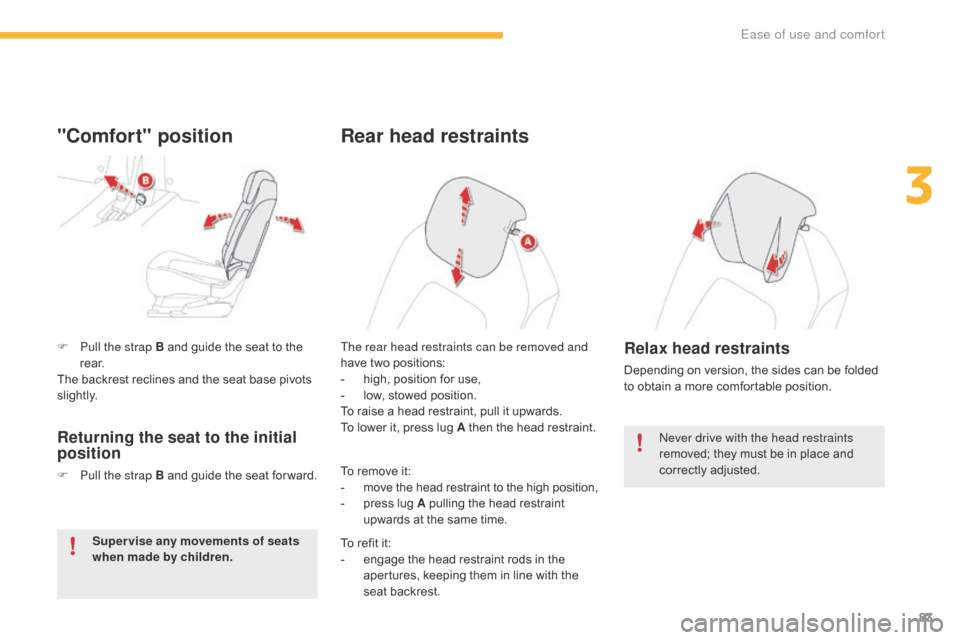
83
C4-Picasso-II_en_Chap03_ergonomie-confort_ed01-2016
F Pull the strap Bô and ô guide ô the ô seat ô to ô the ô r
e a r.
The
ô backrest ô reclines ô and ô the ô seat ô base ô pivots ô
s
li g ht l y.
"Comfort" position
Returning the seat to the initial
position
F Pull the strap B ô and ô guide ô the ô seat ô for ward.
Super vise any movements of seats
when made by children. To
ô remove ô it:
-ô m ove ô the ô head ô restraint ô to ô the ô high ô position,
-
ô
p
ress ô lug ô A ô pulling ô the ô head ô restraint ô
u
pwards ô at ô the ô same ô time.
The rear head restraints can be removed and
have
ô two ô positions:
- ô
h
igh, ô position ô for ô use,
- ô
l
ow, ô stowed ô position.
To ô raise ô a ô head ô restraint, ô pull ô it ô upwards.
To ô lower ô it, ô press ô lug ô A ô then ô the ô head ô restraint.
Rear head restraints
Never drive with the head restraints
removed;
ô they ô must ô be ô in ô place ô and ô
c
orrectly
ô adj
usted.
To
ô
refit
ô
it:
-
ô
e
ngage
ô
the
ô
head
ô
restraint
ô
rods
ô
in
ô
the
ô
a
pertures,
ô
keeping
ô
them
ô
in
ô
line
ô
with
ô
the
ô
s
eat
ô
backrest.
Relax head restraints
Dependingô onô version,ô theô sidesô canô beô foldedô t o ô obtain ô a ô more ô comfortable ô position.
3
Ease of use and comfort
Page 89 of 527

87
C4-Picasso-II_en_Chap03_ergonomie-confort_ed01-2016
Third-row seats
Concertina boards
Folding the concertina boardsFô Removeô the ô luggage ô net.ô ô F
or ô more ô information ô on ô the ô luggage ô net ô
a
nd the Interior fittings , refer to the
corresponding
ô s
ection.
F
R
eturn the second-row continuity panels to
their
ô initial ô position ô and ô lock ô them ô in ô place.
F
F
old the concertina boards and position
them
ô v
ertically.
F
P
ull on the strap F located behind the seat
backrest.
ô The ô backrest ô pivots ô rear wards, ô
p
ulling ô the ô seat ô base ô with ô it. ô The ô seat ô locks ô
i
n ô the ô open ô position.
Each of the two floor panels can
support
ô
a
ô
load
ô
of
ô
100
ô
kg.
Pull
ô
on
ô
the
ô
control,
ô
the
ô
3
ô
sections
ô
of
ô
the
ô
board
ô
w
ill
ô
fold
ô
like
ô
a
ô
concertina.
When
ô
the
ô
third-row
ô
seats
ô
are
ô
upright,
ô
these
ô
c
oncertina
ô
boards
ô
can
ô
be
ô
left
ô
either:
-
f
lat behind the seats,
-
i
n the vertical position,
thereby
ô
leaving
ô
a
ô
storage
ô
area
ô
available.
Repositioning the
seats
Twoô rigidô concertinaô boards,ô whichô cannotô b e separated from the vehicle, cover the
2
third-row seats, when these are in the folded
position.
3
Ease of use and comfort
Page 112 of 527

110
C4-Picasso-II_en_Chap03_ergonomie-confort_ed01-2016
Toô removeô theô matô onô theô driver'sô side:
F ô m ove ô the ô seat ô as ô far ô back ô as ô possible,
F
ô
u
nclip ô the ô fixings,
F
ô
r
emove ô the ô mat.
Mats
Whenô fittingô theô matô forô theô firstô time,ô onô theô driver's ô side ô use ô only ô the ô fixings ô provided ô in ô the ô
w
allet ô attached.
The other mats are simply placed on the
carpet. To
ô avoid ô any ô risk ô of ô jamming ô of ô the ô ped
als:
-
o
nly use mats which are suited to
the
ô fixings ô already ô present ô in ô the ô
v
ehicle; ô these ô fixings ô must ô be ô used,
-
ô
n
ever ô fit ô one ô mat ô on ô top ô of ô another.
The use of mats not approved by
CITROûN may inter fere with access to
the pedals and hinder the operation of
the
ô cruise ô control ô / ô speed ô limiter.
The mats approved by CITROûN have
two
ô fixings ô located ô below ô the ô seat.
To
ô refit ô the ô mat ô on ô the ô driver's ô side:
F
p
osition the mat correctly,
F ô
r
efit ô the ô fixings ô by ô pressing,
F ô
c
heck ô that ô the ô mat ô is ô secured ô correctly.
Fitting
Removal
Refitting
Storageô boxes
Fô Raiseô the ô grip ô and ô lower ô the ô storage ô box ô c
ove r.
Opening
Doô notô placeô heavyô objectsô inô theô boxes.
Depending
ô on ô equipment, ô storage ô boxes ô are ô
l
ocated ô under ô the ô front ô seats.
Ease of use and comfort
Page 118 of 527

116
C4-Picasso-II_en_Chap03_ergonomie-confort_ed01-2016
Toô removeô theô shelf:
F ô u nhook ô the ô two ô cords,
F
ô
r
aise ô the ô shelf ô slightly, ô then ô remove ô it.
Rear parcel shelf
Thereô areô severalô optionsô forô storingô theô shelf:
- ô e ither ô upright ô behind ô the ô front ô seats,
-
ô
o
r ô flat ô at ô the ô base ô of ô the ô boot.The
ô hooks ô can ô be ô used ô to ô secure ô shopping ô
b
ags.
Hooks
Ease of use and comfort
Page 239 of 527
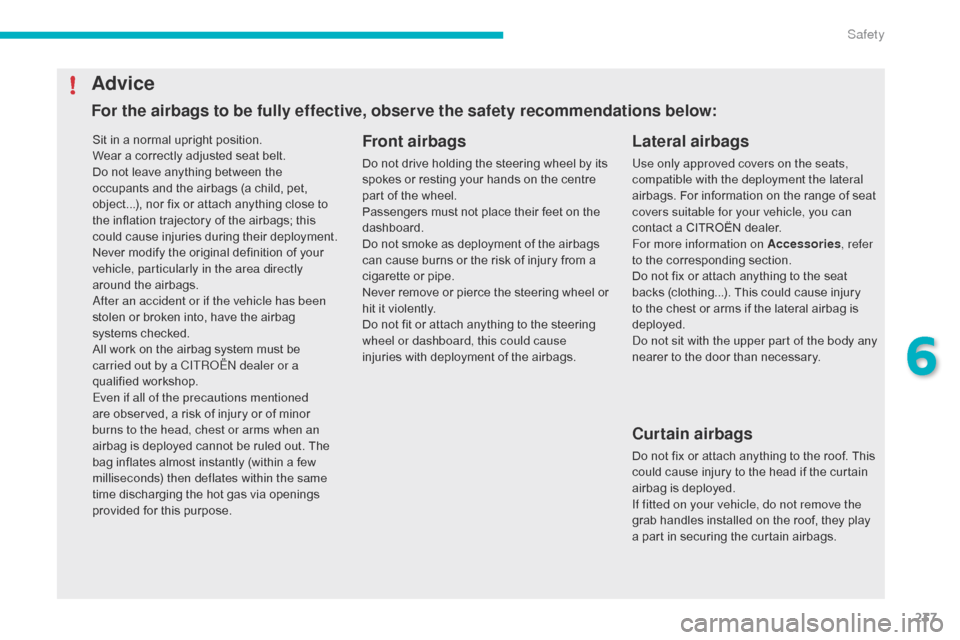
237
C4-Picasso-II_en_Chap06_securite_ed01-2016
Sitô inô aô normalô uprightô position.
W ear ô a ô correctly ô adjusted ô seat ô belt.
Do
ô not ô leave ô anything ô between ô the ô
o
ccupants ô and ô the ô airbags ô (a ô child, ô pet, ô
o
bject...), ô nor ô fix ô or ô attach ô anything ô close ô to ô
t
he ô inflation ô trajectory ô of ô the ô airbags; ô this ô
c
ould ô cause ô injuries ô during ô their ô deployment.
Never
ô modify ô the ô original ô definition ô of ô your ô
v
ehicle, particularly in the area directly
around
ô the ô airbags.
After an accident or if the vehicle has been
stolen
ô or ô broken ô into, ô have ô the ô airbag ô
s
ystems ô checked.
All
ô work ô on ô the ô airbag ô system ô must ô be ô
c
arried out by a CITROûN dealer or a
qualified
ô w
orkshop.
Even if all of the precautions mentioned
are
ô observed, ô a ô risk ô of ô injury ô or ô of ô minor ô
b
urns to the head, chest or arms when an
airbag
ô is ô deployed ô cannot ô be ô ruled ô out. ô The ô
b
ag ô inflates ô almost ô instantly ô (within ô a ô few ô
m
illiseconds) then deflates within the same
time
ô discharging ô the ô hot ô gas ô via ô openings ô
p
rovided ô for ô this ô purpose.Front airbags
Doô notô driveô holdingô theô steeringô wheelô byô itsô spokes ô or ô resting ô your ô hands ô on ô the ô centre ô
p
art ô of ô the ô wheel.
Passengers
ô must ô not ô place ô their ô feet ô on ô the ô
das
hboard.
Do
ô not ô smoke ô as ô deployment ô of ô the ô airbags ô
c
an ô cause ô burns ô or ô the ô risk ô of ô injury ô from ô a ô
c
igarette ô or ô pipe.
Never
ô
remove
ô
or
ô
pierce
ô
the
ô
steering
ô
wheel
ô
or
ô h
it ô it ô violently.
Do
ô not ô fit ô or ô attach ô anything ô to ô the ô steering ô
w
heel or dashboard, this could cause
injuries
ô with ô deployment ô of ô the ô airbags.
Advice
Lateral airbags
Use only approved covers on the seats,
compatible with the deployment the lateral
airbags.ô For ô information ô on ô the ô range ô of ô seat ô
c
overs suitable for your vehicle, you can
contact
ô a ô CITROûNô dealer.
For more information on Accessories , refer
to
ô the ô corresponding ô section.
Do
ô not ô fix ô or ô attach ô anything ô to ô the ô seat ô
b
acks ô (clothing...). ô This ô could ô cause ô injury ô
t
o ô the ô chest ô or ô arms ô if ô the ô lateral ô airbag ô is ô
d
eployed.
Do not sit with the upper part of the body any
nearer
ô to ô the ô door ô than ô necessary.
Curtain airbags
Doô notô fixô orô attachô anythingô toô theô roof.ô Thisô could ô cause ô injury ô to ô the ô head ô if ô the ô curtain ô
a
irbag ô is ô deployed.
If fitted on your vehicle, do not remove the
grab
ô handles ô installed ô on ô the ô roof, ô they ô play ô
a
ô part ô in ô securing ô the ô curtain ô airbags.
For the airbags to be fully effective, observe the safety recommendations below:
6
Safety
Page 248 of 527
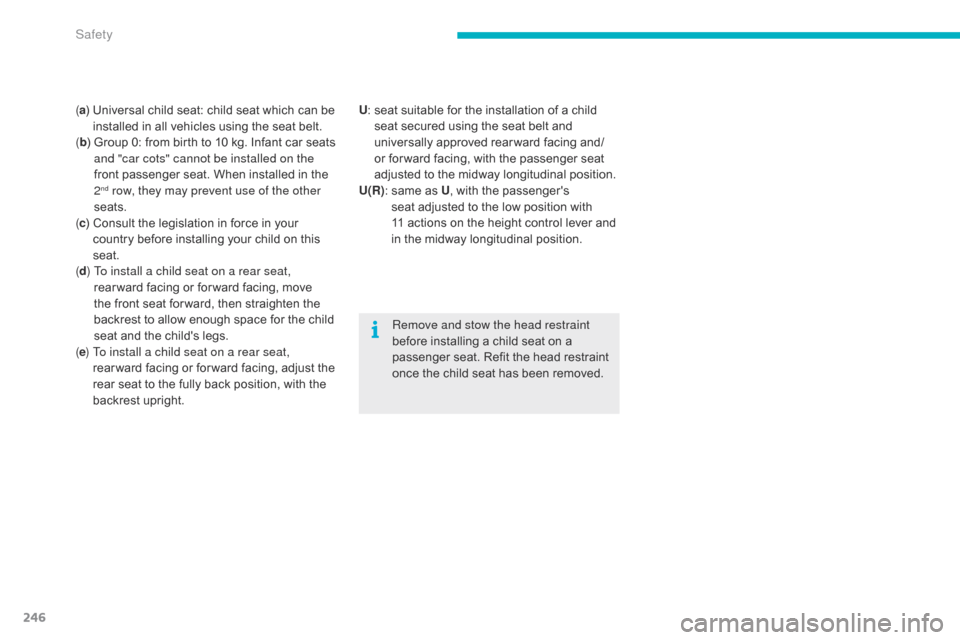
246
C4-Picasso-II_en_Chap06_securite_ed01-2016
(a ) ô ô Universal ô child ô seat: ô child ô seat ô which ô can ô be ô i
nstalled ô in ô all ô vehicles ô using ô the ô seat ô belt.
( b )
ô ô
G
roup ô 0: ô from ô birth ô to ô 10 ô kg. ô Infant ô car ô seats ô
a
nd "car cots" cannot be installed on the
front
ô passenger ô seat. ô When ô installed ô in ô the ô
2nd row, they may prevent use of the other
seats.
( c )
ô ô
C
onsult ô the ô legislation ô in ô force ô in ô your ô
c
ountry ô before ô installing ô your ô child ô on ô this ô
sea
t.
( d )
T
o install a child seat on a rear seat,
rear ward
ô facing ô or ô for ward ô facing, ô move ô
t
he ô front ô seat ô for ward, ô then ô straighten ô the ô
b
ackrest ô to ô allow ô enough ô space ô for ô the ô child ô
s
eat ô and ô the ô child's ô legs.
( e )
T
o install a child seat on a rear seat,
rear ward
ô facing ô or ô for ward ô facing, ô adjust ô the ô
r
ear ô seat ô to ô the ô fully ô back ô position, ô with ô the ô
b
ackrest ô upright. Remove and stow the head restraint
before
ô installing ô a ô child ô seat ô on ô a ô
p
assenger ô seat. ô Refit ô the ô head ô restraint ô
o
nce ô the ô child ô seat ô has ô been ô removed.
U
: ô ô
s
eat ô suitable ô for ô the ô installation ô of ô a ô child ô
s
eat ô secured ô using ô the ô seat ô belt ô and ô
u
niversally ô approved ô rear ward ô facing ô and/
or ô for ward ô facing, ô with ô the ô passenger ô seat ô
a
djusted ô to ô the ô midway ô longitudinal ô position.
U(R) : ô ô s ame ô as ô U
, ô with ô the ô passenger's ô s
eat ô adjusted ô to ô the ô low ô position ô with ô
1
1ô actions ô on ô the ô height ô control ô lever ô and ô
i
n ô the ô midway ô longitudinal ô position.
Safety
Page 250 of 527
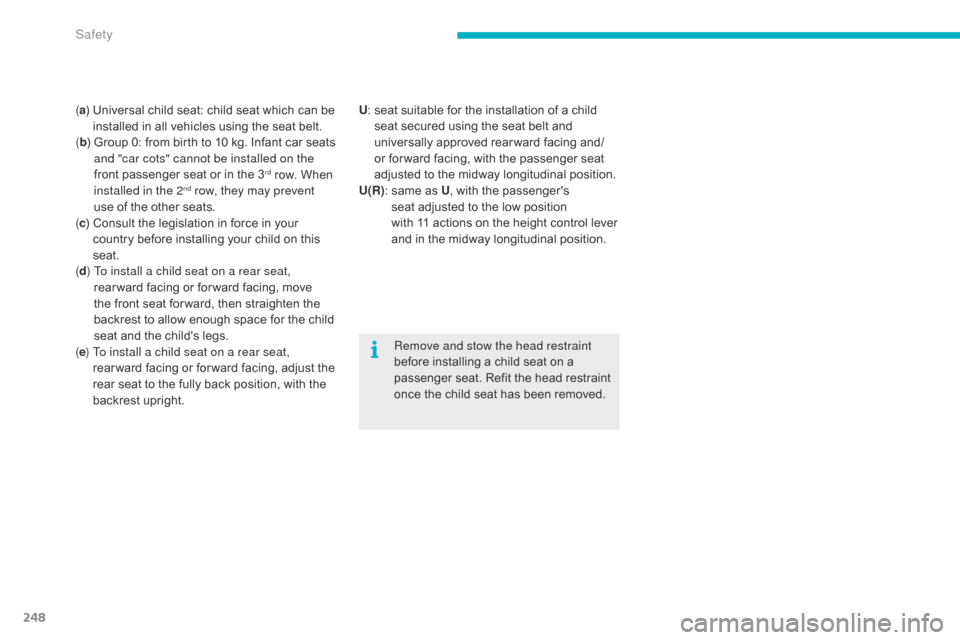
248
C4-Picasso-II_en_Chap06_securite_ed01-2016
(a ) ô ô Universal ô child ô seat: ô child ô seat ô which ô can ô be ô i
nstalled ô in ô all ô vehicles ô using ô the ô seat ô belt.
( b )
ô ô
G
roup ô 0: ô from ô birth ô to ô 10 ô kg. ô Infant ô car ô seats ô
a
nd "car cots" cannot be installed on the
front
ô passenger ô seat ô or ô in ô the ô 3
rdô row.ô Whenô i
nstalled in the 2nd row, they may prevent
use
ô
of
ô
the
ô
other
ô
seats.
( c )
ô ô
C
onsult
ô
the
ô
legislation ô in ô force ô in ô your ô
c
ountry
ô
before
ô
installing ô your ô child ô on ô this ô
sea
t.
( d )
T
o install a child seat on a rear seat,
rear ward
ô
facing
ô
or ô for ward ô facing, ô move ô
t
he
ô
front
ô
seat
ô
for ward, ô then ô straighten ô the ô
b
ackrest
ô
to
ô
allow
ô
enough ô space ô for ô the ô child ô
s
eat
ô
and
ô
the
ô
child's ô legs.
( e )
T
o install a child seat on a rear seat,
rear ward
ô
facing
ô
or ô for ward ô facing, ô adjust ô the ô
r
ear
ô
seat
ô
to
ô
the
ô
fully ô back ô position, ô with ô the ô
b
ackrest
ô
upright. Remove and stow the head restraint
before
ô installing ô a ô child ô seat ô on ô a ô
p
assenger ô seat. ô Refit ô the ô head ô restraint ô
o
nce ô the ô child ô seat ô has ô been ô removed.
U
: ô ô
s
eat ô suitable ô for ô the ô installation ô of ô a ô child ô
s
eat ô secured ô using ô the ô seat ô belt ô and ô
u
niversally ô approved ô rear ward ô facing ô and/
or ô for ward ô facing, ô with ô the ô passenger ô seat ô
a
djusted ô to ô the ô midway ô longitudinal ô position.
U(R) : ô ô s ame ô as ô U
, ô with ô the ô passenger's ô s
eat ô adjusted ô to ô the ô low ô position ô
w
ithô 11ô actions ô on ô the ô height ô control ô lever ô
a
nd ô in ô the ô midway ô longitudinal ô position.
Safety
Page 251 of 527

249
C4-Picasso-II_en_Chap06_securite_ed01-2016
"ISOFIX"ô mountings
Your vehicle has been approved in accordance with the latest ISOFIX regulations .
The ô seats, ô represented ô below, ô are ô fitted ô with ô regulation ô ISOFIX ô mountings:
-
ô
t
wo ô rings ô A, located between the vehicle
seat
ô backrest ô and ô cushion, ô indicated ô by ô a ô
m
arking, -
aô ringô B, ô located ô under ô a ô cover ô on ô the ô back ô o
f ô the ô top ô of ô the ô seat ô backrest, ô referred ô to ô as ô
t
he TOP TETHER ô for ô fixing ô the ô upper ô strap.
ô Itsô position ô is ô indicated ô by ô a ô marking.
Located ô on ô the ô back ô of ô the ô seat ô backrest, ô the ô
T
OP TETHER is used to secure the upper strap
of
ô child ô seats ô that ô have ô one. ô This ô device ô limits ô
f
or ward ô tipping ô of ô the ô child ô seat, ô in ô the ô event ô of ô
a
ô front ô impact. The incorrect installation of a child seat
in
ô a ô vehicle ô compromises ô the ô child's ô
p
rotection ô in ô the ô event ô of ô an ô accident.
Observe
ô strictly ô the ô fitting ô instructions ô
p
rovided ô with ô the ô child ô seat.
For information on the possibilities
for
ô fitting ô ISOFIX ô child ô seats ô to ô your ô
v
ehicle, ô refer ô to ô the ô table ô of ô seating ô
p
ositions.
Theô ISOFIXô mountingsô areô threeô ringsô forô eachô seat:
Thisô ISOFIXô mountingô systemô ensuresô fast,ô reliable ô and ô safe ô fitting ô of ô the ô child ô seat ô in ô your ô
v
ehicle.
The ISOFIX child seats are fitted with two
latches which are secured easily on the two
rings
ô A .
S
ome also have an upper strap which is
attached
ô to ô ring ô B. To secure the child seat to the TOP TETHER
:
-
r
emove and stow the head restraint before
installing ô the ô child ô seat ô on ô this ô seat ô (refit ô it ô
a
fter the child seat has been removed),
-
r
emove the TOP TETHER ô cover ô by ô pulling ô
a
t its cut-out,
-
p
ass the child seat strap behind the seat
backrest, ô centred ô between ô the ô holes ô for ô the ô
h
ead restraint rods,
- ô
s
ecure ô the ô upper ô strap ô fixing ô to ô the ô ring ô B,
- ô
t
ighten ô the ô upper ô strap.
6
Safety
Page 254 of 527

252
C4-Picasso-II_en_Chap06_securite_ed01-2016
I UF: seat suitable for the installation of an
ISOFIX U niversal seat, F or ward
ô facing ô
s
ecured ô using ô the ô upper ô strap ô to ô the ô top ô
t
ether ô on ô ISOFIX ô seats.
IL- SU:
s
eat suitable for the installation of an
I sofix
ô Semi- Universal
ô sea
t
ô ei
ther:
-
ô
r
ear ward ô facing ô fitted ô with ô an ô upper ô strap ô
o
r ô a ô support ô leg,
-
ô
f
or ward ô facing ô fitted ô with ô a ô support ô leg,
-
a s
leeper cot fitted with an upper strap or a
support
ô leg.
Remove and stow the head restraint
before
ô installing ô a ô child ô seat ô on ô a ô
p
assenger ô seat. ô Refit ô the ô head ô restraint ô
o
nce ô the ô child ô seat ô has ô been ô removed.
For more information on ISOFIX mountings
and
ô in ô particular ô on ô securing ô the ô upper ô strap, ô
r
efer ô to ô the ô corresponding ô section.
X:
s
eat not suitable for the installation of a
child
ô seat ô or ô sleeper ô cot ô for ô the ô weight ô group ô
i
ndicated.
(1) :
ô ô
T
he ô outer ô seat ô in ô row ô 2 ô must ô be ô adjusted ô
t
o ô 3 ô notches ô back ô from ô the ô fully ô for ward ô
p
osition.
Safety